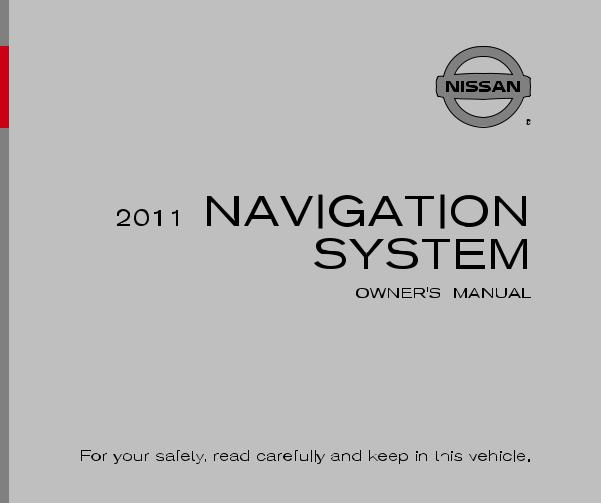NISSAN Maxima User Manual

NISSAN NAVIGATION SYSTEM HELPDESK CONTACT INFORMATION
For assistance or inquiries about the NISSAN Navigation System, or to order updated map data, contact the NISSAN NAVIGATION SYSTEM HELPDESK at:
. ADDRESS: P.O. Box 1588, Orem, UT
84059-992
. E-MAIL: Nissan-Navi-Info@navteq.com
. WEB SITE: www.NissanNavigation.com
. PHONE: 1-888-661-9995
. HOURS: 6:00 AM to 5:00 PM (Pacific Time)
NISSAN CONSUMER AFFAIRS DEPARTMENT
For assistance or inquiries about the NISSAN warranty, service or general questions, contact the NISSAN Consumer Affairs Department at:
For U.S. customers
Nissan North America, Inc.
Consumer Affairs Department
P.O. Box 685003
Franklin, TN 37068-5003
1-800-NISSAN-1
(1-800-647-7261)
For Canadian customers
Nissan Canada Inc.
5290 Orbitor Drive
Mississauga, Ontario L4W 4Z5
1-800-387-0122
FOREWORD
Thank you for purchasing a NISSAN vehicle.
This user’s manual is for the navigation system only. This manual contains operating instructions for the NISSAN Navigation System offered in your NISSAN vehicle.
Please read this manual carefully to ensure safe operation of the navigation system.
. Because of possible specification changes and optional equipment, sections of this manual may not apply to your vehicle.
. All information, specifications and illustrations in this manual are those in effect at the time of printing. NISSAN reserves the right to change specifications or design at any time without notice.
. Do not remove this manual from the vehicle when selling this vehicle. The next user of this navigation system may need the manual.

Contents
Introduction |
1 |
|
|
|
|
Getting started |
2 |
|
|
|
|
Map settings |
3 |
|
|
|
|
Setting destination |
4 |
|
|
|
|
Route guidance |
5 |
|
|
|
|
Storing location/route |
6 |
|
|
|
|
Viewing technical information |
7 |
|
|
|
|
Other settings |
8 |
|
|
|
|
Voice recognition |
9 |
|
|
|
|
General system information |
10 |
|
|
|
|
Troubleshooting guide |
11 |
|
|
|
|
Index |
12 |
|
|

1 Introduction
How to use this manual .......................................................... |
1-2 |
Safety information ..................................................................... |
1-2 |
For safe operation ............................................................... |
1-2 |
Laser product ............................................................................ |
1-3 |
Reference symbols ............................................................. |
1-2 |
|
|

HOW TO USE THIS MANUAL
This manual uses special words, symbols and icons that are organized by function.
Please refer to the following items to understand how to use this manual properly.
FOR SAFE OPERATION
 WARNING
WARNING
Indicates the presence of a hazard that could cause death or serious personal injury. To avoid or reduce the risk, the procedures must be followed precisely.
 CAUTION
CAUTION
Indicates the presence of a hazard that could cause minor or moderate personal injury or damage to your vehicle. To avoid or reduce the risk, the procedures must be followed carefully.
 NOTE:
NOTE:
Indicates items that help you understand and maximize the performance of your vehicle. If ignored, they may lead to a malfunction or poor performance.
1-2 Introduction
REFERENCE SYMBOLS
 INFO:
INFO:
Indicates information that is necessary for efficient use of your vehicle or accessories.
 Reference page:
Reference page:
Indicates the title and page that you should refer to.
<>:
Indicates a button on the control panel.
[ ]:
Indicates a key/item displayed on the screen.  Voice Command:
Voice Command:
Indicates an operation by voice command.
Variable commands, such as numbers, are indicated in italics in parentheses < >.
SAFETY INFORMATION
This system is primarily designed to help you reach your destination, and it also performs other functions as outlined in this manual. However, you, the driver, must use the system safely and properly. Information concerning road conditions, traffic signs and the availability of services may not always be up to date. The system is not a substitute for safe, proper and legal driving.
Before using the navigation system, please read the following safety information. Always use the system as outlined in this manual.
 WARNING
WARNING
. To operate the navigation system or use the multi-function controller, first park the vehicle in a safe location and set the parking brake. Operating the system while driving can distract the driver and may result in a serious accident.
. Do not rely on route guidance alone. Always be sure that all driving maneuvers are legal and safe in order to avoid accidents.
. Do not disassemble or modify this system. If you do, it may result in accidents, fire or electrical shock.

. If you notice any foreign objects in the system hardware, spill liquid on the system or notice smoke or a smell coming from it, stop using the system immediately and contact a NISSAN dealer. Ignoring such conditions may lead to accidents, fire or electrical shock.
 CAUTION
CAUTION
. Do not use this system if you notice any malfunctions such as a frozen screen or the lack of sound. Continued use of the system may result in accidents, fire or electrical shock.
. Some states/provinces may have laws limiting the use of video screens while driving. Use this system only where it is legal to do so.
. Extreme temperature conditions [below −48F (−208C) and above 1588F (708C)] could affect the performance of the system.
 NOTE:
NOTE:
Do not keep the navigation system running with the engine stopped. Doing so may discharge the vehicle battery. When you use the navigation system, always keep the engine running.
LASER PRODUCT
This navigation system is certified as a Class 1 laser product.
The navigation system complies with DHHS Rules 21 CFR Chapter 1, Subchapter J.
 WARNING
WARNING
. Do not disassemble or modify this system. There are no user serviceable parts in this navigation system.
. If maintenance, adjustments and operations other than those specified in this manual are attempted, injury due to laser radiation and exposure could occur.
Required XM® Radio and XM NavTraffic® monthly subscriptions are sold separately. XM NavTraffic® are only available in select markets. For more information,
see www.xmradio.com/navtraffic.
Introduction 1-3

Required XM® Radio and XM NavWeatherTM monthly subscriptions are sold separately. XM NavWeatherTM is only available in select markets. For more information,
see www.xmradio.com/navweather.
1-4 Introduction
2 Getting started
Control buttons and functions ............................................... |
2-2 |
Control panel ........................................................................ |
2-2 |
MULTI-FUNCTION CONTROLLER ................................ |
2-4 |
Steering wheel switch ....................................................... |
2-4 |
Starting the system ................................................................... |
2-5 |
Navigation system status screen .......................................... |
2-6 |
Functions disabled while driving ........................................... |
2-7 |
Menu screen and how to operate ........................................ |
2-8 |
Menu screens and their purposes .................................. |
2-8 |
Using controls to adjust values, levels, etc. ................. |
2-9 |
Start menu ......................................................................... |
2-10 |
List screen ......................................................................... |
2-11 |
Touch panel operation .......................................................... |
2-12 |
Example of touch panel operation ............................... |
2-12 |
How to input letters and numbers ..................................... |
2-13 |
Character (letters and numbers) input screen ......... |
2-13 |
Number input screen ....................................................... |
2-14 |
.................................................................Map menu screen |
2-15 |
|
Current location map screen ...................................... |
2-15 |
|
|
||
Scrolled location map screen ..................................... |
2-16 |
|
Storing home location/address .......................................... |
2-16 |
|
How to store home location ....................................... |
2-16 |
|
Setting destination ................................................................ |
2-18 |
|
Searching for destination ............................................. |
2-18 |
|
Starting route guidance ................................................ |
2-19 |
|
Canceling route .............................................................. |
2-19 |
|
Operating maps ..................................................................... |
2-20 |
|
How to view map screen ............................................. |
2-20 |
|
Setting voice guidance ........................................................ |
2-21 |
|
Turning voice guidance ON/OFF ............................... |
2-21 |
|
Adjusting voice guidance volume .............................. |
2-22 |
|
NISSAN voice recognition .................................................. |
2-23 |
|
Using the system ........................................................... |
2-23 |
|
Before starting ................................................................ |
2-23 |
|
Giving voice commands ............................................... |
2-23 |
|
Command list .................................................................. |
2-25 |
|

CONTROL BUTTONS AND FUNCTIONS
CONTROL PANEL
Type A
Type B
2-2 Getting started

Type C
*1 <STATUS>:
Push multiple times to display audio information with either the air conditioner status, fuel economy or navigation directions.
*2 <DEST>:
Push to enter a destination. Various methods for entering a destination are available.  “4. Setting destination”
“4. Setting destination”
*3 <ROUTE>:
Push to access guidance control functions (guidance cancellation, route priority, waypoint setting on the route, etc.).
*4 Multi-function controller:
Turn to highlight an item on the screen, push to select the highlighted item or scroll the map.
*5 <INFO>:
Push to display the vehicle, traffic, weather or voice recognition information.
*6 <DAY/NIGHT OFF> :
:
Push to switch between the day screen (bright) and the night screen (dark). Push and hold to turn off the display. Push again to turn on the display.
*7 <SETTING>:
Push to access the system settings.
*8 <VOICE>:
Push to hear the current guidance for a programmed route.
*9 <BACK>:
Push to return to the previous screen. In a settings screen, this button can also be used to apply the setting.
In a character input screen, this button can also delete the characters that have been entered.
*10 <MAP>:
Push to display the map. While following programmed route, push multiple times to change the type of route information.
*11 <ZOOM IN>, <ZOOM OUT>:
Push to switch to the zoom mode to change the map scale.
*12 <DISP>:
Push to access the display settings.
INFO:
. If <BACK> needs to be pushed to apply the setting on a settings screen, this manual will explicitly include a step for this procedure. Otherwise, pushing <BACK> returns the display to the previous screen.
. The layout of the control panel switches may vary depending on the vehicle model and equipment.
Getting started 2-3

MULTI-FUNCTION CONTROLLER
With Directional buttons
*1 <ENTER>:
Push to select the highlighted item on the screen.
If this button is pushed while a map is displayed, the map menu screen is displayed.
*2 Main directional buttons:
Use to move across the map, highlight an item on the screen or adjust a setting (volume, brightness, etc.).
*3 Additional directional buttons:
Use to move across the map or highlight an item on the character input screen.
2-4 Getting started
*4 Center dial:
Turn to highlight an item on the screen or adjust a setting.
Turn the center dial on the map screen. The map scale is displayed. Use the center dial to adjust the map scale.
Without Directional buttons
*1 <ENTER>:
Push to select the highlighted item on the screen.
If this button is pushed while a map is displayed, the map menu screen is displayed.
*2 Center dial/Slide switch: Center dial
Turn to highlight an item on the screen or adjust a setting.
The center dial can also be used to adjust the map scale.
Slide switch
Slide (push upward/downward/leftward/ rightward) to select an item on the screen or to adjust a setting (volume, brightness, etc.)
The map can be scrolled in 8 directions by sliding this switch.
STEERING WHEEL SWITCH
Type A

Type B
*1 <ENTER>:
Tilt to highlight an item on the screen or adjust a setting. Push to select the highlighted item.
If this button is pushed while a map is displayed, the map menu screen is displayed.
 “Map menu screen” (page 2-15)
“Map menu screen” (page 2-15)
Push and hold while a map or status screen is shown to display the Start Menu.
 “Start menu” (page 2-10)
“Start menu” (page 2-10)
If this button is tilted up while the audio function is activated and the map or status screen is displayed, the audio system can be operated.
*2 <+ −>:
−>:
Use to adjust the volume. These buttons have the same function as that of the volume control knob. Refer to the vehicle Owner’s Manual.
*3 < >:
>:
Push this button during a setting operation to return to the previous screen. In a settings screen, this button can also be used to apply the setting.
*4 <TALK  >:
>:
Push to start the voice recognition mode. If the voice recognition mode is already activated, pushing this button cancels the voice guidance and you can speak a voice command immediately.
*5 <SOURCE> :
Use to switch the audio mode (source). Refer to the vehicle Owner’s Manual.
STARTING THE SYSTEM
The navigation system starts when the ignition switch is turned to the ACC or ON position.
 NOTE:
NOTE:
Do not keep the navigation system on with the engine stopped. Doing so may discharge the vehicle battery. When you use the navigation system, always keep the engine running.
Getting started 2-5

NAVIGATION SYSTEM STATUS SCREEN
By pushing <STATUS> at anytime, you can display a split screen with audio information that is always at the top. Each time <STATUS> is pushed, the bottom part of the screen changes between air conditioner, fuel economy or navigation directions.
 INFO:
INFO:
There are different status screens displayed depending on various factors, such as the currently active mode, whether a destination has been set or not, etc.
When a route to the destination is set and the audio system is on, a screen similar to the one above appears.
*1 Turning direction at the next intersection *2 Name of the next street
*3 Distance to the next intersection
*4 Distance remaining to the destination *5 Remaining time to the destination
When a route to the destination is not set and the audio system is off, a screen similar to the one above appears.
2-6 Getting started

FUNCTIONS DISABLED WHILE
DRIVING
To ensure safe driving, some functions cannot be operated or have limited operation while driving.
Park the vehicle in a safe location and then operate the navigation system.
Getting started 2-7

MENU SCREEN AND HOW TO OPERATE
MENU SCREENS AND THEIR PURPOSES
Push <DEST>, <ROUTE>, <INFO> , <SETTING>or<PHONE> (if so equipped) to display the corresponding menu screen.
How to select a menu item
Example: <DEST> screen
1.Highlight the preferred menu item using the multi-function controller.
2.To select the preferred menu item, highlight the item and push <ENTER>. The next screen is displayed.
2-8 Getting started
3.Push <BACK> to return to the previous screen without applying any changes.
Push <MAP> to return to the current location map screen without applying any changes.
 INFO:
INFO:
An item can also be selected by tilting <ENTER> on the steering wheel up and down.

USING CONTROLS TO ADJUST VALUES, LEVELS, ETC.
With directional buttons
Getting started 2-9

. These same adjustments can also be performed using the touch panel operation.  “Adjusting volume and others”
“Adjusting volume and others”
(page 2-12)
START MENU
The start menu can be displayed using the steering wheel switch.
Without directional buttons
There are five main methods to control the navigation system: the center dial, the main directional buttons, the slide switch, the touch panel and the switches on the steering wheel. Use these controls to adjust the volume of the phone and voice guidance, the display brightness, etc.
How to adjust
1.Highlight the preferred setting item and push <ENTER>. The color of the corresponding adjustment item changes.
2.Adjust the value or level of the indicator bar using the multi-function controller.
3.Push <ENTER> or <BACK> to apply the setting.
INFO:
. The volume of phone and voice guidance, the display brightness, etc. can be adjusted by tilting <ENTER> on the steering wheel up and down.
1.Push and hold <ENTER> on the steering wheel.
2.Highlight the preferred item and push
<ENTER>.
 INFO:
INFO:
<ENTER> on the steering wheel switch can be used to display the start menu only when the map or status screen is displayed.
2-10 Getting started

Available items
. [Destination]:
Displays the destination screen. It is the same screen that appears when <DEST> is pushed.
 “4. Setting destination”
“4. Setting destination”
. [Route]:
Displays the route screen. It is the same screen that appears when <ROUTE> is pushed.
 “5. Route guidance”
“5. Route guidance”
. [Info]:
Displays the information screen. It is the same screen that appears when <INFO> is pushed.
 “7. Viewing technical information”
“7. Viewing technical information”
. [Settings]:
Displays the settings screen. It is the same screen that appears when <SETTING> is pushed.
 “8. Other settings”
“8. Other settings”
LIST SCREEN
After searching for a point of interest, a list screen is displayed.
Depending on the list displayed, it can be sorted.
Items displayed in a list
*1 Highlight the preferred item from the list and push <ENTER> to select it. If a location or facility name is not completely displayed (due to length), highlight the item to display the hidden part of the name.
*2 Distance from the current location *3 Direction to the point of interest
*4 If the entire list cannot be displayed on the screen, the system displays the total number of items in the list and the entry number of the selected item. Scroll the list using the multi-function controller.
*5 An item that starts with the selected letter will be displayed at the top of the list.
Getting started 2-11

*6
*7
*8
Highlight and push <ENTER> to sort the list in the original order.
When the list is sorted by the shortest distance, the selected location can be confirmed in the preview on the right side of the screen.
Highlight and push <ENTER> to modify search conditions.
TOUCH PANEL OPERATION
With this system, the same operations as those for the multi-function controller are possible using the touch panel operation.
This manual describes the operations using the multi-function controller.
For the operations that differ from those of the multi-function controller and for useful methods for using the touch panel operation, refer to each section.
EXAMPLE OF TOUCH PANEL OPERATION
Here, the operation examples performed with the touch panel operation are described.
Selecting item
When the item is touched, the next screen is displayed.
Adjusting volume and others
Touch [+] or [−] located on the right and left of the bar graph to perform the adjustment.
Scrolling message or list
Touch [ ] or [
] or [ ] to scroll the message or list. Touch [
] to scroll the message or list. Touch [ ] or [
] or [ ] to skip to the next page.
] to skip to the next page.
2-12 Getting started

Inputting letters and numbers
1.Touch the letter or number.
2.To delete a character, touch [Delete]. Push and hold [Delete] to delete all of the characters.
HOW TO INPUT LETTERS AND NUMBERS
CHARACTER (letters and numbers) INPUT SCREEN
When setting a destination, searching for a facility or editing the stored locations, etc. alphanumeric characters must be entered into the system.
1.Use the multi-function controller to highlight a character on the displayed keyboard.
2.Push <ENTER>. The highlighted character is entered.
3.Push <BACK>, or highlight [Delete] and push <ENTER> to delete the last character entered.
Push and hold <BACK> to delete all the characters entered.
Highlight [Space] and push <ENTER> to enter a space.
4.After finishing the entry, highlight [List] and push <ENTER>.
Getting started 2-13

INFO:
. Push <BACK> on the control panel to return to the previous screen, but only after deleting all the characters entered.
. When [BACK] is touched on the screen, the screen returns to the previous screen even when characters have been entered.
. When text has been entered and the number of matching list items has been narrowed down enough so that they fit on the screen, the list screen appears automatically.
Symbol input screen
 INFO:
INFO:
Symbol keys are displayed by highlighting [Symbols] and pushing <ENTER>. Alphabet keys are displayed by highlighting [A-Z] and pushing <ENTER>.
NUMBER INPUT SCREEN
A phone number or a street number can also be entered as a search method to look for a destination.
 INFO:
INFO:
Only the locations included in the map data database can be searched for by a phone number.
1.Use the multi-function controller to highlight a number on the displayed keyboard.
2.Push <ENTER>. The highlighted number is entered.
3.Push <BACK>, or highlight [Delete] and push <ENTER> to delete the last number entered.
Push and hold <BACK> to delete all the numbers entered.
4.After finishing the entry, highlight [List] and push <ENTER>.
2-14 Getting started

INFO:
. <BACK> can be pushed on the control panel to return to the previous screen, but only after deleting all the numbers entered.
. When [BACK] is touched on the screen, the screen returns to the previous screen even when numbers have been entered.
MAP MENU SCREEN
Push <ENTER> while the current location map screen or a scrolled map screen is displayed to display the menu corresponding to that screen.
This menu can be used to access helpful functions quickly, such as setting a destination and searching for points of interest nearby.
To select a menu item, use the method described earlier in this manual.
 “Menu screen and how to operate” (page 2-8)
“Menu screen and how to operate” (page 2-8)
 INFO:
INFO:
With the touch operation, the same screen can be displayed by touching [Map Menu] located on the map screen.
CURRENT LOCATION MAP SCREEN
If <ENTER> is pushed while the current location map screen is displayed, the following options are available.
. [Store Location]:
Store the current vehicle location in the Address Book. The stored location can be retrieved as necessary to set it as a destination (waypoint).
 “Storing location” (page 6-2)
“Storing location” (page 6-2)
. [Nearby Places]:
Search for points of interest near the current vehicle location, such as restaurants and gas stations, etc.
 “Finding nearby place” (page 4-5)
“Finding nearby place” (page 4-5)
. [Map View]:
Perform map operations such as the switching of map type and the setting of map orientation and scale.
 “3. Map settings”
“3. Map settings”
. [Map Icons]:
Select map icons of certain points of interest (such as restaurants and gas stations, etc.) to be displayed on the map around the current vehicle location.
 “Displaying map icons” (page 3-17)
“Displaying map icons” (page 3-17)
. [Store Tracking]:
Store in the Address Book the route travelled from the starting point to the current location.
 “Storing tracked route” (page 6-6)
“Storing tracked route” (page 6-6)
Getting started 2-15

SCROLLED LOCATION MAP SCREEN
If <ENTER> is pushed while a scrolled map screen is displayed, the following options are available.
. [New Dest.]:
Set the destination to the map location where <ENTER> was pushed. If a destination is already set, the location will be set as the new destination.
 “Setting point on map” (page 4-19)
“Setting point on map” (page 4-19)
. [Add to Route]:
Set the map location where <ENTER> was pushed as a destination or a waypoint. This is available only when the suggested route is already set.
 “Setting destination or waypoint” (page 5-14)
“Setting destination or waypoint” (page 5-14)
. [Nearby Places]:
Search for points of interest near the map location where <ENTER> was pushed and
2-16 Getting started
set them as a destination or waypoint.
Use the same search method as the one for [Places].
 “Finding nearby place” (page 4-5)
“Finding nearby place” (page 4-5)
. [Store Location]:
Store in the Address Book the map location where <ENTER> was pushed. The stored location can be retrieved to set it as a destination or waypoint.
 “Storing location” (page 6-2)
“Storing location” (page 6-2)
. [Delete]:
Delete a stored location. To delete it, place the cross pointer over the corresponding icon.
. [Incident Detail]:
This function can be selected only when the traffic information icon is displayed. Display the details of the traffic information icon.
Place the cross pointer over the icon you want to check.
 INFO:
INFO:
Incident details are a feature of Traffic Information, and that an XM NavTraffic® subscription is required in order to receive Traffic Information.
STORING HOME LOCATION/ ADDRESS
HOW TO STORE HOME LOCATION
If a home location is already stored in the Address Book, it can be easily retrieved to set the route to the stored home location.
The procedure to store the home location is the same as for storing any other location.
 “4. Setting destination”
“4. Setting destination”
As an example, the procedure for storing the home location by searching for a destination by address is described here.
1.Push <DEST>.
2.Highlight [Home (Add New)] and push
<ENTER>.

3.A confirmation message is displayed. Confirm the contents of the message, highlight [Yes] and push <ENTER>.
4.Highlight [Street Address] and push <ENTER>. A character input screen is displayed.
5.Enter the address of the home location,
highlight [OK] and push <ENTER>.  “Finding address” (page 4-4) The map screen is displayed.
“Finding address” (page 4-4) The map screen is displayed.
6.Adjust the location of your home using the muti-function controller, if necessary.
7.After adjusting the location, push
<ENTER>.
8.A message is displayed and the home location is stored.
9.Highlight [OK] and push <ENTER>.
10.Push <MAP> to return to the current location map screen. The home icon is displayed on the map.
 INFO:
INFO:
The same setting can also be performed by pushing <SETTING> and highlighting [Navigation].
 “Storing location by searching” (page 6-2)
“Storing location by searching” (page 6-2)
Getting started 2-17

SETTING DESTINATION
SEARCHING FOR DESTINATION
As an example, the method for setting a restaurant as the destination using [Places] is described here.
1.Push <DEST>.
2.Highlight [Places] and push <ENTER>.
3.Highlight [Nearby RESTAURANT] and push
<ENTER>.
2-18 Getting started
 INFO:
INFO:
The search can also be narrowed down by selecting [All Categories or Name] or [ZAGAT] on this screen. By selecting [All Categories or Name], the area, name of facility, etc. can be specified. By selecting [ZAGAT], restaurants registered in the ZAGAT database can be searched and sorted by its rating regarding food, decor, cost, service, etc.
4.Highlight the preferred restaurant from the list and push <ENTER>.
 INFO:
INFO:
. The position of the selected location is displayed in the preview on the right side of the screen.
. If there is a route already in progress, only places along the current route will be listed. Turn off [Show Along Route] at the
top of list to display all nearby places.
5.The entire route is shown on the map. Highlight [Start] after confirming the location of the displayed destination, and push
<ENTER>.
The system sets the destination to the selected location and starts calculating a route.
 INFO:
INFO:
Even after setting a destination, the location of the destination can be adjusted, the route can be stored, etc. if necessary.
 “Procedures after setting destination” (page 5-2)
“Procedures after setting destination” (page 5-2)

STARTING ROUTE GUIDANCE
After setting the destination and performing route calculation, the suggested route is displayed.
1. Highlight [Start] and push <ENTER>.
2.Once route guidance is started, the system navigates through the guide points using visual and voice guidance.
3.When approaching a guide point, the system automatically changes to the split screen and shows an enlarged view of the intersection in the left screen.
Push <MAP> to switch to the full map screen.
4.When arriving at the destination, route guidance automatically ends.
CANCELING ROUTE
Delete a route that is already set according to the following procedure.
1.Push <ROUTE>.
2.Highlight [Cancel Route] and push
<ENTER>.
3.A confirmation message is displayed. Highlight [Yes] and push <ENTER>.
Getting started 2-19

INFO:
. If a route is canceled, [Cancel Route] changes to [Resume Route].
Highlight [Resume Route] and push <ENTER> to reactivate the canceled route. This is available only until a new route is set or a currently set destination is deleted.
. The above step does not delete the destination that has been set. To delete a destination, push <DEST> and highlight [Delete Destination], then push <ENTER>.  “Delete destination” (page 4-20)
“Delete destination” (page 4-20)
OPERATING MAPS
HOW TO VIEW MAP SCREEN
The navigation system displays various information on the map screen.
Screen information
*1  Vehicle icon:
Vehicle icon:
Indicates the current vehicle location and the direction of travel.
*2  Starting point:
Starting point:
Displays the vehicle location, with which the route is set, as the starting point.
*3  Guide point:
Guide point:
Indicates a guide point on the route. *4  Waypoint:
Waypoint:
Displays locations between the starting point and the destination. A maximum of 5 waypoints can be set.
2-20 Getting started

*5  Destination:
Destination:
Indicates the destination location of the route guidance.
When you reach your destination, the address will be displayed on the map screen.
*6 Suggested route:
Appears in bold yellow during route guidance.
*7  Map Menu icon:
Map Menu icon:
Touch the icon to display the Map Menu screen.
 “Map menu screen” (page 2-15)
“Map menu screen” (page 2-15)
*8  /
/ Direction indicator:
Direction indicator:
Indicates the directional setting of the map. Touch the icon to change the setting.
 : North always pointing up.
: North always pointing up.
: Traveling direction always pointing up. “Setting map orientation” (page 3-14)
*9 Scale indicator: Indicates the scale of the map.
Touch the icon to display the scale bar. This allows the map scale to be adjusted.  “Operating with touch operation”
“Operating with touch operation”
(page 3-10)
*10 Street name:
Displays the name of the street that the vehicle is currently driving on.
SETTING VOICE GUIDANCE
TURNING VOICE GUIDANCE ON/OFF
Voice guidance can be activated or deactivated.
1.Push <ROUTE>.
2.Highlight [Guidance Settings] and push
<ENTER>.
3.Highlight [Guidance Voice] and push <ENTER>. The indicator illuminates if voice guidance is activated.
Getting started 2-21

Other settings |
1. |
Push <ROUTE>. |
Voice guidance can also be activated or |
2. |
Highlight [Guidance Settings] and push |
deactivated using the following procedure. |
|
<ENTER>. |
1. |
Push <SETTING>. |
|
3. Highlight [Guidance Volume] and push |
2. |
Highlight [Volume & |
Beeps] and push |
<ENTER>. |
|
<ENTER>.
3.Highlight [Guidance Voice] and push
<ENTER>.
ADJUSTING VOICE GUIDANCE VO-
LUME
The voice guidance volume can be adjusted.
4. Adjust the volume of voice guidance by using the multi-function buttons.
Other settings
Voice guidance volume can also be adjusted using the following procedure.
1.Push <SETTING>.
2.Highlight [Volume & Beeps] and push
<ENTER>.
3.Highlight [Guidance Volume] and push
<ENTER>.
4.Adjust the volume of voice guidance by using the multi-function buttons.
 INFO:
INFO:
The volume can also be adjusted by turning the audio system volume control knob or pushing +/− on the steering wheel switch while voice guidance is being announced.
 “Steering wheel switch” (page 2-4)
“Steering wheel switch” (page 2-4)
2-22 Getting started

NISSAN VOICE RECOGNITION
NISSAN Voice Recognition allows hands-free operation of the navigation system and other systems equipped on this vehicle, such as the phone, vehicle information and audio. NISSAN Voice Recognition can be used in one of two selectable modes, Standard Mode or Alternate Command Mode.
In Standard Mode, the commands that are available are always shown on the display and announced by the system. To perform operations, simply follow the prompts given by the system.
For advanced operation, change to Alternate Command Mode. When this mode is active, an expanded list of commands can be spoken after pushing <TALK > on the steering wheel switch and the voice command menu prompts are turned off. Note that in this mode the recognition success rate may be affected because the number of available commands and ways of speaking each command are increased. Otherwise, it is recommended that Alternate Command Mode be turned to OFF and Standard Mode be used for the best recognition performance.
> on the steering wheel switch and the voice command menu prompts are turned off. Note that in this mode the recognition success rate may be affected because the number of available commands and ways of speaking each command are increased. Otherwise, it is recommended that Alternate Command Mode be turned to OFF and Standard Mode be used for the best recognition performance.
For U.S. customers, Standard Mode is selected by default. For Canadian customers, Alternate Command Mode is the default mode.
Otherwise, it is recommended that Alternate
Command Mode be turned to OFF and Standard Mode be used for the best recognition performance.
INFO:
. For voice recognition system operation related to the phone, audio or vehicle information systems, refer to the Owner’s Manual of your vehicle.
. When the system language is set to “Franc¸ais” (French) or “Espan˜ol” (Spanish), the available commands and functions may differ from those that are available when using the system in English.
USING THE SYSTEM
Initialization
When the ignition switch is pushed to the ON position, NISSAN Voice Recognition is initialized, which may take up to one minute. When completed, the system is ready to accept voice commands. If <TALK > is pushed before the initialization completes, the display will show the message: “System not ready.”
> is pushed before the initialization completes, the display will show the message: “System not ready.”
BEFORE STARTING
To get the best recognition performance from NISSAN Voice Recognition, observe the following points:
. The interior of the vehicle should be as quiet as possible. Close the windows to eliminate the surrounding noises (traffic noise and vibration sounds, etc.), which may prevent the system from correctly recognizing the voice commands.
. The voice recognition system cannot be operated when the soft top is not closed (for Roadster and Cross Cabriolet models).
. Wait until the tone sounds before speaking a command.
. Speak in a natural conversational voice without pausing between words.
. If the air conditioner is set to “Auto”, the fan speed is automatically lowered so that voice commands can be recognized more easily.
GIVING VOICE COMMANDS
The method of giving a voice command in Standard Mode is described in this section.
Getting started 2-23
